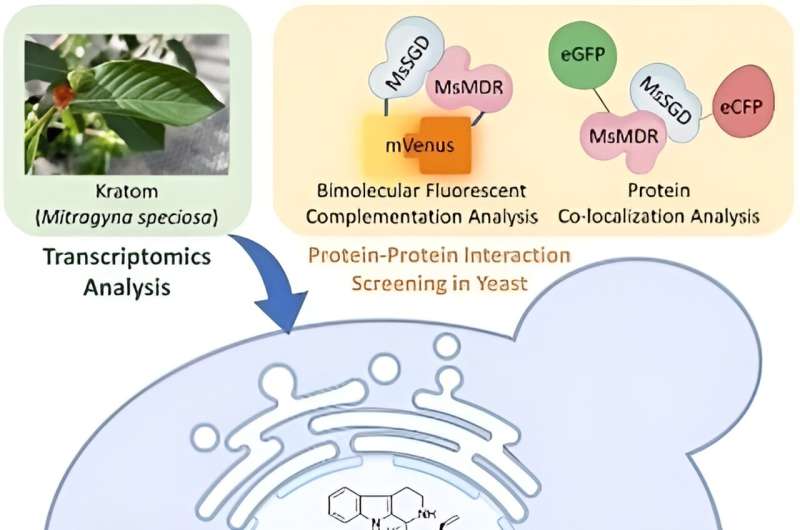Yeast speeds discovery of medicinal compounds in plants

Cornell researchers have harnessed the power of baker's yeast to create a cost-effective and highly efficient approach for unraveling how plants synthesize medicinal compounds, and used the new method to identify key enzymes in a kratom tree.
Aspirin, morphine and some chemotherapies are examples of drugs that are derived from natural compounds produced by plants. Understanding how a plant creates such compounds usually begins with analyzing plant transcriptomes to identify up to hundreds of genes that could potentially code for the enzymes that work together to facilitate production. Each gene must then be biochemically characterized using specific substrates and reaction conditions—a laborious and expensive task that stifles the discovery process.
A new yeast-based screening method detailed in the journal Angewandte Chemie captures protein-protein interactions between plant enzymes, working in tandem with other screening methods to better pinpoint which genes are ultimately responsible for how a plant biosynthesizes medicinal compounds.
"Traditional methods find groups of proteins that exist in the plant at the same time, but our method complements that by looking at which of those groups physically cluster and play well with each other," said Sijin Li, assistant professor of chemical and biomolecular engineering and lead author of the study. "Those are the ones responsible for the type of chemicals we might want to extract for a pharmaceutical."
Once gene candidates are predicted using plant transcriptomics, baker's yeast—the same kind used for brewing beer and baking bread—is engineered with the genes inside to see which ones produce proteins that interact with each other. As a result, the number of genes that must then be biochemically screened is significantly reduced.
"This method had been underutilized for pathway discovery and eliminates a big bottleneck for high-throughput screening," Li said. "It's cheaper and safer than using chemical substrates, and it's highly efficient and accurate."
Li and her research group demonstrated the yeast-based method using kratom leaves. Kratom is a tropical tree native to southeast Asia and although not well studied, has gained attention from the research community because of its pharmaceutical potential, according to Li.
"It produces a chemical called mitragynine, which some people call a next-generation opioid because it has a painkilling effect without leading to dangerous respiratory depression," said Li, who added that the U.S. Food and Drug Administration has warned against the use of kratom as it has not approved any drugs containing the tree. "Producing pure mitragynine can help lower the risks associated with using the entire kratom matrix by ultimately leading to a safer treatment."
The yeast-based method led to the identification of six kratom enzymes from 20 candidates predicted by genetic screening to produce mitragynine or other targeted chemicals. Subsequent biochemical testing showed that none of the 14 discarded candidates were functional enzymes, while four of the six identified by the yeast-based method were functional. Li said the method's accuracy opens the door for a more efficient discovery process and continued research on the kratom tree.
"For clinical trials, the chemical has to be purified from the plant or synthesized using a chemical approach, which is very expensive," Li said. "Using the yeast method, we can more economically produce mitragynine and other chemicals that might lead us to new pharmaceuticals."
More information: Yinan Wu et al, Discovering Dynamic Plant Enzyme Complexes in Yeast for Kratom Alkaloid Pathway Identification, Angewandte Chemie International Edition (2023). DOI: 10.1002/anie.202307995
Journal information: Angewandte Chemie , Angewandte Chemie International Edition
Provided by Cornell University Kratom's reputed pain-relief benefits could come from one of its metabolites
No comments:
Post a Comment